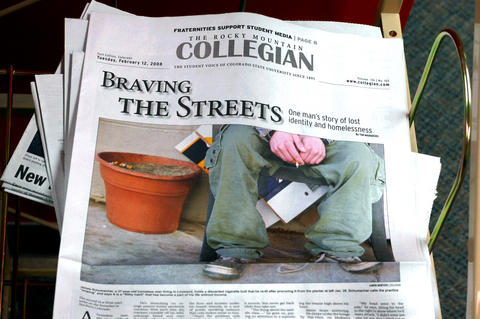J. David McSwane, the student editor of The Rocky Mountain Collegian, was looking forward to a quiet spring semester at the Colorado State University after drawing global attention last fall for a four-word editorial criticizing US President George W. Bush.
What he got instead was another storm.
On the first day of classes in January, McSwane learned that the university president was meeting with representatives from the local daily, The Fort Collins Coloradoan, which is owned by Gannett, to discuss a potential "partnership" with the student newspaper.

PHOTO : NY TIMES NEWS SERVICE
The Collegian, now worried about its future as an independent student newspaper, is planning to fight any possible takeover by a media company. And Gannett and The Coloradoan have become targets for harsh criticism from college newsrooms and journalism departments across the country, who portray Gannett as a "dark lord" that wants to rein in student press freedom.
"If The Coloradoan were to take over The Collegian, only Gannett would win," The Daily Nebraskan, the campus newspaper at the University of Nebraska-Lincoln, said in an editorial.
Gannett dismissed any suggestion that it planned to conquer student journalism.
"There is no grand Gannett strategy," said Tara Connell, a spokeswoman at its headquarters in McLean, Virginia. "Gannett is not looking to buy college newspapers. We look at all sorts of things."
Gannett owns two student newspapers in Florida, however - The Tallahassee Democrat owns The FSView & Florida Flambeau at Florida State and Florida Today owns The Central Florida Future at the University of Central Florida in Orlando. Both are for-profit newspapers, although the vast majority of student newspapers, including The Collegian, are nonprofit.
US media companies find college newspapers attractive properties for several reasons: operating costs are low because student labor is inexpensive, sometimes even free. Advertising is on the rise. And perhaps most important, the newspapers are read - frequently - by a young audience with relatively deep pockets.
In 2006, MTV acquired Y2M: Youth Media and Marketing Networks, whose subsidiary, College Publisher, is host of Web sites for 450 campus newspapers.
"College communities are fairly healthy economic engines. There's a constant influx of students coming in with cash," said Kevin Schwartz, the general manager of The Daily Tar Heel, the student newspaper at the University of North Carolina-Chapel Hill. "The underpinnings of a healthy market are found in a state university town."
According to Alloy Media and Marketing, which places advertisements in college publications, advertisers spent US$30 million on ads in college papers in 2006. Alloy also estimated that advertising in college newspapers increased 15 percent in 2007, from 2006.
And as John Morton, a newspaper industry analyst in Silver Spring, Maryland, noted, college newspapers have a captive audience. A 2006 survey conducted by College Publisher found that 44 percent of undergraduate students read their campus newspaper twice or more a week - compared with 28 percent who read the local newspaper that often - and 77 percent read it at least once a month.
College print publications are still beating their online counterparts as well - only 24 percent of respondents said they read the college paper online twice or more a week. (Of national publications, USA Today, Gannett's flagship publication, has the second-highest readership on campuses, behind The New York Times, the survey noted.)
College newsrooms are also relatively immune to the market pressures of the industry. "Our primary focus isn't bringing money to stockholders, it's providing opportunities for students," said McSwane, The Collegian editor, who is a junior from Arvada, Colorado. "We don't ever have to worry that someone's going to come down and say, 'Hey, we have to cut our newsroom budget because someone in Kansas isn't making enough money.'"
That independence from the bottom line is what keeps student journalism fresh and irreverent, or so holds the common wisdom in college newsrooms, and journalism professors tend to agree. "If there is free press, it's probably on the college campuses," said Donna Rouner, a journalism professor at Colorado State who wrote an op-ed for The Collegian criticizing any deal.
No proposal has yet been submitted, but an advisory committee composed of students, including a representative from The Collegian, and Colorado State faculty members held its first meeting last Thursday to decide whether a deal with Gannett or any other media company was worth pursuing.
Blanche Hughes, the vice president for student affairs, who sits on the committee, said its goal was to gauge how the proposal would work for students as well as the university. She said the committee would look for job and education opportunities for students and assurances from any company that made a bid for The Collegian that the quality of the newspaper would be maintained.
Morton said he doubted that Gannett's ownership would change a student newspaper. "I'm sure Gannett has absolutely no interest in having anything to do with the editorial product," he said.
But buying student newspapers, Morton said, made financial sense. "It's a way of enlarging your footprint," he said.
Schwartz, the general manager of The Daily Tar Heel, said he thought Gannett was going after young readers. But he said campus newspapers, with their easy availability and focus on community-based journalism, helped to instill the newspaper habit in students.
"Let us make them newspaper readers for you," he said.

Behind a car repair business on a nondescript Thai street are the cherished pets of a rising TikTok animal influencer: two lions and a 200-kilogram lion-tiger hybrid called “Big George.” Lion ownership is legal in Thailand, and Tharnuwarht Plengkemratch is an enthusiastic advocate, posting updates on his feline companions to nearly three million followers. “They’re playful and affectionate, just like dogs or cats,” he said from inside their cage complex at his home in the northern city of Chiang Mai. Thailand’s captive lion population has exploded in recent years, with nearly 500 registered in zoos, breeding farms, petting cafes and homes. Experts warn the

No one saw it coming. Everyone — including the Chinese Nationalist Party (KMT) — expected at least some of the recall campaigns against 24 of its lawmakers and Hsinchu Mayor Ann Kao (高虹安) to succeed. Underground gamblers reportedly expected between five and eight lawmakers to lose their jobs. All of this analysis made sense, but contained a fatal flaw. The record of the recall campaigns, the collapse of the KMT-led recalls, and polling data all pointed to enthusiastic high turnout in support of the recall campaigns, and that those against the recalls were unenthusiastic and far less likely to vote. That

The unexpected collapse of the recall campaigns is being viewed through many lenses, most of them skewed and self-absorbed. The international media unsurprisingly focuses on what they perceive as the message that Taiwanese voters were sending in the failure of the mass recall, especially to China, the US and to friendly Western nations. This made some sense prior to early last month. One of the main arguments used by recall campaigners for recalling Chinese Nationalist Party (KMT) lawmakers was that they were too pro-China, and by extension not to be trusted with defending the nation. Also by extension, that argument could be

Aug. 4 to Aug. 10 When Coca-Cola finally pushed its way into Taiwan’s market in 1968, it allegedly vowed to wipe out its major domestic rival Hey Song within five years. But Hey Song, which began as a manual operation in a family cow shed in 1925, had proven its resilience, surviving numerous setbacks — including the loss of autonomy and nearly all its assets due to the Japanese colonial government’s wartime economic policy. By the 1960s, Hey Song had risen to the top of Taiwan’s beverage industry. This success was driven not only by president Chang Wen-chi’s